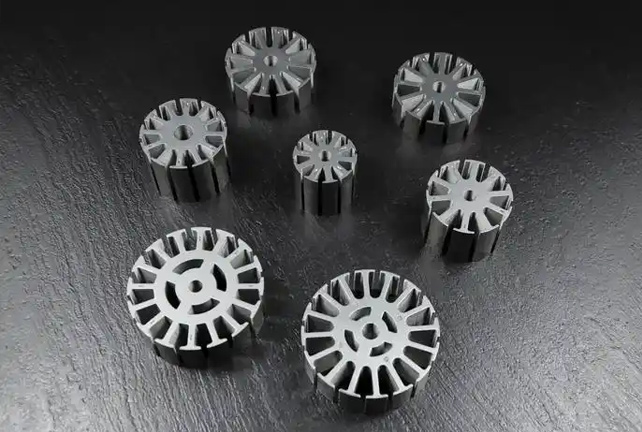Electric motors are the backbone of modern industrial and consumer applications, powering everything from household appliances to electric vehicles. At the heart of these motors lies a critical component known as motor lamination. This article explores what motor lamination is, how it works, and why it is indispensable for efficient motor performance.
1. Understanding Motor Lamination
Motor lamination refers to the thin, stacked layers of electrical steel (also called silicon steel or laminations) that form the core of an electric motor’s stator and rotor. These laminations are typically made from specialized steel alloys and are coated with an insulating material to minimize energy losses.
Key Features of Motor Lamination:
- Material: Electrical steel, often silicon-based, is used due to its high magnetic permeability and low electrical conductivity.
- Thickness: Laminations are usually between 0.1 mm and 0.5 mm thick to reduce eddy currents.
- Insulation: Each layer is insulated with a oxide or varnish coating to prevent electrical contact between sheets.
- Shape: Laminations are stamped or laser-cut into precise shapes to fit the motor’s design.
2. How Motor Lamination Works
The primary function of motor laminations is to enhance the motor’s magnetic circuit while minimizing energy losses. Here’s how it works:
A. Reducing Eddy Current Losses
When an electric motor operates, alternating magnetic fields induce currents in the conductive core material. If the core were a solid block of metal, these eddy currents would generate significant heat, wasting energy and reducing efficiency. By using thin, insulated laminations, the path for eddy currents is disrupted, drastically lowering energy loss.
B. Improving Magnetic Flux
Laminations are designed to align with the motor’s magnetic field, ensuring smooth flux flow. The high permeability of electrical steel allows the magnetic field to pass through with minimal resistance, enhancing torque and performance.
C. Minimizing Hysteresis Losses
Hysteresis loss occurs when the magnetic domains in the core material realign with the changing magnetic field, generating heat. Silicon steel laminations are optimized to reduce this effect, further improving efficiency.
3. Why Motor Lamination is Important
Motor lamination is crucial for several reasons, impacting performance, efficiency, and longevity.
A. Energy Efficiency
Laminated cores significantly reduce energy losses, making motors more efficient. This is especially vital in applications like electric vehicles and industrial machinery, where energy savings translate to cost reductions and environmental benefits.
B. Heat Reduction
By minimizing eddy currents and hysteresis losses, laminations prevent excessive heating. Overheating can degrade insulation, warp components, and shorten the motor’s lifespan.
C. Enhanced Performance
Precision-cut laminations ensure optimal magnetic flux distribution, leading to smoother operation, higher torque, and better speed control.
D. Noise Reduction
Solid cores can vibrate due to magnetic forces, causing noise. Laminations dampen these vibrations, resulting in quieter motor operation.
E. Cost-Effectiveness
While the lamination process adds manufacturing steps, the long-term savings from reduced energy consumption and maintenance outweigh the initial costs.

4. Types of Motor Laminations
Motor laminations vary based on application and design requirements:
A. stator laminations
The stator is the stationary part of the motor. Its laminations are typically ring-shaped with slots to hold copper windings.
B. rotor laminations
The rotor rotates inside the stator. Its laminations are often designed with slots or bars for squirrel-cage induction motors or permanent magnets for brushless motors.
C. Custom Laminations
High-performance motors may use custom laminations with unique shapes or materials to meet specific torque, speed, or efficiency demands.
5. Manufacturing Process of Motor Laminations
Producing high-quality laminations involves several steps:
1. Material Selection: Electrical steel with the right silicon content is chosen.
2. Cutting/Stamping: Sheets are cut into precise shapes using dies or lasers.
3. Insulation Coating: A thin insulating layer is applied to each lamination.
4. Stacking: Layers are stacked and bonded using adhesives, welding, or interlocking.
5. Annealing: Heat treatment may be used to relieve stress and improve magnetic properties.
6. Challenges in Motor Lamination
Despite its benefits, motor lamination faces challenges:
- Material Costs: High-quality electrical steel can be expensive.
- Precision Requirements: Imperfections in cutting or stacking can degrade performance.
- Insulation Integrity: Poor coating can lead to interlamination shorts.
7. Future Trends in Motor Lamination
Advancements in materials and manufacturing are shaping the future:
- Amorphous Metals: New alloys with lower core losses.
- Additive Manufacturing: 3D-printed laminations for complex designs.
- Sustainable Materials: Eco-friendly insulation coatings.
8. Conclusion
Motor lamination is a foundational technology that enables efficient, reliable, and high-performance electric motors. By reducing energy losses, minimizing heat, and optimizing magnetic flux, laminations play a pivotal role in everything from household appliances to renewable energy systems. As technology evolves, innovations in lamination materials and processes will continue to drive the next generation of motor efficiency.
Understanding the importance of motor lamination helps engineers and designers create better motors, contributing to a more energy-efficient and sustainable future. Whether in EVs, industrial machines, or consumer electronics, the humble lamination remains an unsung hero of modern electromechanical systems.

Copyright © Zhejiang Xinzheng Electromechanical Technology Co., Ltd. All Rights Reserved.
This website uses cookies to ensure you get the best experience on our website.
Comment
(0)